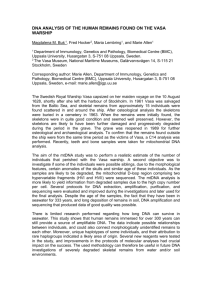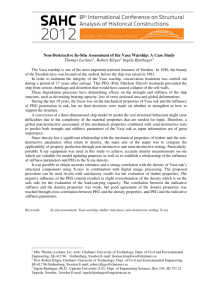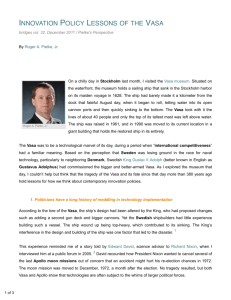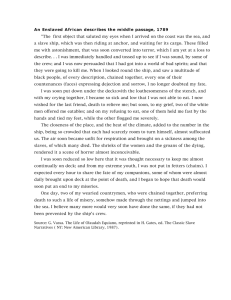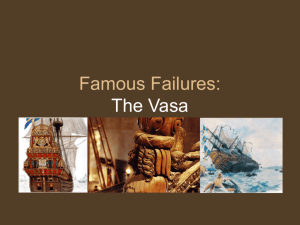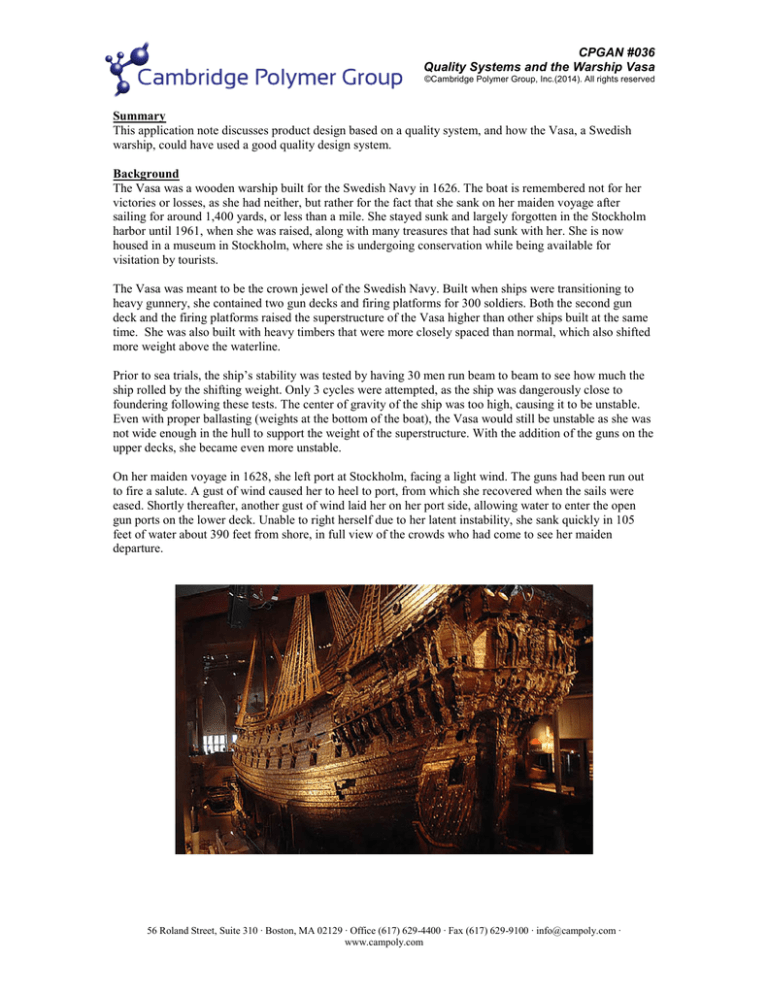
CPGAN #036
Quality Systems and the Warship Vasa
©Cambridge Polymer Group, Inc.(2014). All rights reserved
Summary
This application note discusses product design based on a quality system, and how the Vasa, a Swedish
warship, could have used a good quality design system.
Background
The Vasa was a wooden warship built for the Swedish Navy in 1626. The boat is remembered not for her
victories or losses, as she had neither, but rather for the fact that she sank on her maiden voyage after
sailing for around 1,400 yards, or less than a mile. She stayed sunk and largely forgotten in the Stockholm
harbor until 1961, when she was raised, along with many treasures that had sunk with her. She is now
housed in a museum in Stockholm, where she is undergoing conservation while being available for
visitation by tourists.
The Vasa was meant to be the crown jewel of the Swedish Navy. Built when ships were transitioning to
heavy gunnery, she contained two gun decks and firing platforms for 300 soldiers. Both the second gun
deck and the firing platforms raised the superstructure of the Vasa higher than other ships built at the same
time. She was also built with heavy timbers that were more closely spaced than normal, which also shifted
more weight above the waterline.
Prior to sea trials, the ship’s stability was tested by having 30 men run beam to beam to see how much the
ship rolled by the shifting weight. Only 3 cycles were attempted, as the ship was dangerously close to
foundering following these tests. The center of gravity of the ship was too high, causing it to be unstable.
Even with proper ballasting (weights at the bottom of the boat), the Vasa would still be unstable as she was
not wide enough in the hull to support the weight of the superstructure. With the addition of the guns on the
upper decks, she became even more unstable.
On her maiden voyage in 1628, she left port at Stockholm, facing a light wind. The guns had been run out
to fire a salute. A gust of wind caused her to heel to port, from which she recovered when the sails were
eased. Shortly thereafter, another gust of wind laid her on her port side, allowing water to enter the open
gun ports on the lower deck. Unable to right herself due to her latent instability, she sank quickly in 105
feet of water about 390 feet from shore, in full view of the crowds who had come to see her maiden
departure.
56 Roland Street, Suite 310 ∙ Boston, MA 02129 ∙ Office (617) 629-4400 ∙ Fax (617) 629-9100 ∙ info@campoly.com ∙
www.campoly.com
CPGAN #036
Quality Systems and the Warship Vasa
©Cambridge Polymer Group, Inc.(2014). All rights reserved
Quality Systems on the Vasa
So what happened, and what does this have to do with quality systems? A good quality management
system for designing a new device has several phases. A design team is set up, with experience in the
product or field, manufacturing, and testing requirements. The performance requirements or specifications
are established, so the team knows what criteria they need to meet in the design. A design and failure
modes effects analysis (DFMEA) is set up, determining what the potential failure modes are in the device,
what the potential ramifications of these failures are, and how to test for them. Design verification tests are
listed and performed on relevant portions of the device during prototype development based on the
DFMEA. Regular design meetings should take place, documenting testing and design modifications. Once
a prototype is in place, end user feedback on the prototype allows changes in the design as necessary, along
with re-testing. If the feedback is all positive and the device has met all of the required specifications, the
design is considered validated and the design is frozen. A manufacturing process can them be designed.
For the Vasa, several steps in the design process were skipped, which may have resulted in her ignominious
first and last sail. Five months after construction started, the king (upper management) ordered too many
guns to fit on a single gun deck, requiring the addition of a second gun deck. Thus, a change in product
specifications occurred after the design freeze, which is always problematic in device design. Because the
king was in a hurry to replace ships that were lost in battle, no design testing of individual elements of the
ship could be conducted to ensure the new concept of two gun decks and shooting platforms was stable or
safe. The original shipbuilder died during construction, and there is evidence the second shipbuilder tried to
increase the width of the hull, but could not deviate much from the original design as construction was
already underway. In the inquest that followed the sinking, master shipwrights opined that the ship was
top-heavy, showing that although sailing mechanics were still in their infancy, there was sufficient
empirical knowledge to know what designs worked and what did not. A larger and more experienced
design team might have pointed out this liability in the design.
During the one verification test that was conducted, where the stability was tested by having men run from
one side of the deck to another, the instability of the boat was observed, and unfortunately ignored.
Although late in the manufacturing process, the ship could have been stripped down and revised based on
this information. Certainly, the DFMEA would have suggested that the higher center of gravity would have
a critical impact on performance, and hence should be designed around.
Unfortunately, the only end user feedback available was from the sailors who were on the Vasa’s maiden
voyage. Although no records are available, it is likely that they would feel that the performance
specifications were not met. The implementation of a good quality management system would have almost
definitely improved the outcome in this example. Contact CPG for more information on how a quality
management system can lead to better results for your company.
56 Roland Street, Suite 310 ∙ Boston, MA 02129 ∙ Office (617) 629-4400 ∙ Fax (617) 629-9100 ∙ info@campoly.com ∙
www.campoly.com


